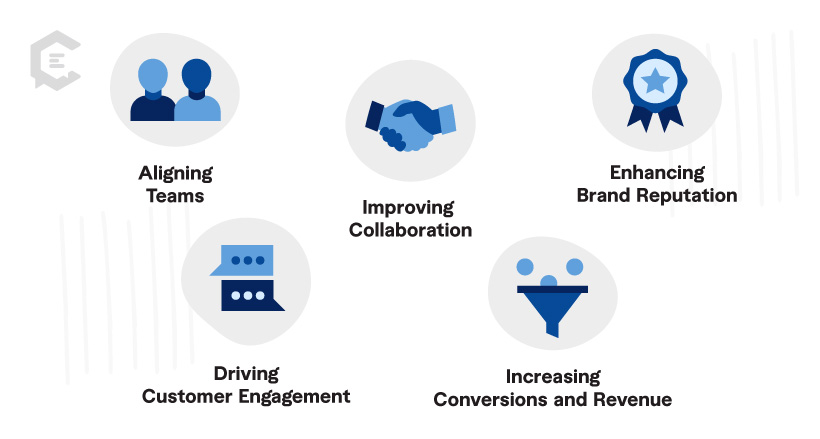The ascent of content marketing has revolutionized business communication, accentuating the power of value-creation and meaningful relationships. It’s a powerful strategy that helps companies connect with their audience, generate leads, and build brand loyalty.
However, in this day and age, merely implementing content marketing tactics is not enough.
It’s become essential to foster a content marketing culture within organizations. A culture where content strategy isn’t just an isolated function of the marketing department. But rather a mindset permeating all aspects of the business.
To truly unlock the full potential of your content marketing, you have to foster a strong content marketing culture that permeates every level and department of your organization. This comprehensive guide will show you how.

Unpacking the Concept of a Content Marketing Culture
Although content marketing is essential for digital marketing success, only about 29 percent of marketers are actually seeing results. That means that the majority of us need to look at how we can develop a more effective process. But, we also need to foster a culture for content marketing within our organization to set up those processes and drive success.
A content marketing culture is an organizational philosophy where every team member appreciates the significance of content in attaining business objectives. That culture extends beyond the marketing team, effectively interweaving the content strategy into the entire company’s operation.

The critical role of a content marketing culture
A strong content marketing culture brings numerous benefits to organizations, such as:
- Aligning teams
- Improving collaboration
- Enhancing brand reputation
- Driving customer engagement
- Increasing conversions and revenue
A content marketing culture will establish your business as a thought leader in your industry. That’ll help you gain a competitive edge and build long-term relationships with your target audience.
The Role of Leadership in Fostering Culture
Leaders are in a prime position to shape attitudes and behaviors that lead to effective content creation and management. Any strong, sustainable culture starts from the top.

Setting the tone for a content-centric culture
Leadership’s first step in fostering a content-centric culture should be to emphasize the importance of content in the organization’s overall strategy. This involves:
- Communicating the value of content: Leaders can articulate why content is critical to the company’s success and deserves robust resources. This includes demonstrating how content drives engagement, builds brand loyalty, and ultimately contributes to the business’s bottom line.
- Leading by example: Leaders should actively engage with content initiatives and show a visible commitment that can inspire and motivate the entire organization. That can mean personally contributing to a company blog, participating in webinars, or actively spearheading a content campaign.
- Encouraging innovation: Leaders can also create a safe environment for experimentation by encouraging teams to think outside the box. That can mean trying new content types, formats, or platforms, all while knowing that not every effort is going to succeed. But each provides valuable learning opportunities.
Building a sustainable content culture
A content culture doesn’t stop once you lay the foundation. Leaders should continuously nurture its growth to ensure its longevity and effectiveness. This involves a multifaceted approach of:
- Regular reviews and adjustments: Leaders should also review content strategies periodically to ensure they’re staying aligned with evolving business goals and market conditions. And if they’re not, they shouldn’t be afraid to adjust accordingly and communicate to their team why.
- Fostering a collaborative spirit: Leaders sometimes have to thread the needle between boss and cheerleader. That means holding regular team meetings and content brainstorming sessions to encourage a sense of community and collaboration around content creation.
- Acknowledging success: Rewards and recognition are powerful motivators. Leaders shouldn’t be afraid to call out and showcase individuals or teams who produce exceptional content or demonstrate innovative content strategies.
- Performance metrics: Metrics are essential for content success. Leaders should establish clear and relevant KPIs. That might include engagement rates, lead generation, or conversions (among others).
Bottom line, leadership is instrumental in fostering a content-centric culture and fueling the “content village” that’s essential for modern marketing success.
Cultivating a Content Marketing Culture: The Three Phases
Following a structured approach is essential when creating a content marketing culture within your organization. Here are the three phases to navigate the process successfully:
Assessment: Gauging your current marketing culture
First, you need to assess your organization’s current marketing culture to identify areas for improvement. You can do this by:
- Conducting internal surveys: Administer surveys to gather feedback from team members. Questions can be asked about their understanding of content marketing, current involvement in content-related efforts, and perception of the existing content marketing practices.
- Identifying strengths and weaknesses: Analyze your survey results to identify strengths and weaknesses within your current culture and process. Discover thriving areas and leverage those as a foundation for development. Use them as a guiding light for weaknesses that require refinement.
- Conduct a content audit: Perform a thorough analysis of your existing content assets. Evaluate the quality, relevance, and performance metrics to gain insights into your efforts thus far. You’ll quickly find areas of expertise, saturation, and content gaps.
By conducting a comprehensive assessment, you will clearly understand your current culture and establish a baseline for future progress.
Planning: Establishing your content marketing goals
Post-assessment, establish your content marketing objectives using the SMART framework. Each goal should be specific, measurable, relevant to target audiences, and achievable with your available resources.
It’s vital to ensure that your content goals align with your organization’s overall business objectives. This alignment reinforces the strategic value. Plus, it contributes to the bottom line.
Prioritize your content marketing goals by importance and feasibility. This can help you determine the sequence to pursue them in, and it will also allow you to better map out any dependencies or relevant resources.

Implementation: Building a proficient content marketing team
A proficient content marketing team is essential. A good team will help you to execute your content marketing strategy effectively. Follow these actionable steps to assemble a team with the necessary skills and expertise:
Define roles and responsibilities
Clearly define the roles and responsibilities within your content marketing team. Identify individuals responsible for each stage of the process and overall coordination. Ensure each team member understands their role and how it contributes to the larger content marketing goals. Everyone needs to know what they’re doing and where they fit in the larger process.
As you’re doing this, you might realize that your in-house team may not have the capacity you’ve determined for their roles and responsibilities. If that’s the case, consider outsourcing some of those responsibilities. Alternatively, determine which aspects of their positions are of priority to achieve your goals.
Some essential roles you should consider include:
- Content Strategist: Oversees content planning, production, and promotion.
- Content Writer: Generates various content types, from blog posts to infographics.
- Content Editor: Reviews content before publication to ensure brand adherence, grammatical correctness, and best practices.
- SEO Specialist: Optimizes content to enhance search engine visibility.
- Social Media Manager: Distributes content through various social platforms.
- Analytics Specialist: Tracks content performance to fine-tune strategy.
Invest in training and development
Invest in different training and development initiatives. This will equip your team with the necessary skills for effective content creation and strategy execution.
You can do this via workshops, webinars, online courses, or by granting access to industry resources. Some relevant areas of training could be:
- A refresh on general content marketing best practices
- SEO techniques
- Storytelling
- Data analysis
Foster cross-functional collaboration
Encouraging collaboration and communication shouldn’t stop within your content marketing team. It’s essential to spread it across other departments, such as sales, customer success, and product.
You’ll foster better interdepartmental collaboration and workflows by facilitating regular meetings, brainstorming sessions, and knowledge-sharing initiatives. It’ll also allow you to tap into the diverse expertise throughout your organization.
Develop a content workflow
Establish a clear content workflow. Outline the processes and approvals required from ideation to content creation, editing, review, and publishing. This workflow ensures efficiency, accountability, and quality control throughout the content production cycle.

Overcoming Challenges in Building a Content Marketing Culture
While cultivating a content marketing culture can be immensely rewarding, it’s not without challenges. Addressing these challenges head-on ensures a smooth transition and successful implementation. Some hurdles to overcome include:
Resistance to change
The first step to tackling resistance is to articulate the advantages of content marketing. Then, demonstrate how it bolsters overall business goals. Foster a workplace that welcomes change and encourages innovation.
Limited resources
Resource constraints can impede the implementation of a content marketing culture. Efficient planning, reasonable allocation of resources, along with leveraging affordable content marketing tools can help overcome this issue.

Measuring and communicating the ROI of content marketing
Measuring the tangible impact of content marketing can pose a challenge. Employing advanced analytics tools can help track engagement, conversions, and other relevant metrics. Regularly sharing these insights can amplify the organization’s understanding of the value of content marketing.
Maintaining a Sustainable Content Marketing Culture
Building a content marketing culture is not enough. To be sustainable, you have to nurture and maintain it over time.
This involves ongoing training and development to keep your team updated with industry trends while encouraging collaboration and creativity. Plus, regularly review and update your content strategy to remain relevant in a rapidly evolving landscape.
Begin Building Your Content Culture
Fostering a content marketing culture is a strategic investment and a continuous journey rather than a destination.
As a marketing leader, your role is pivotal in spearheading such a transformative change. One that regards content as a strategic linchpin. Embark on this journey today and witness your organization thrive in the content marketing era.
Start building your content marketing culture today and achieve remarkable business growth. Unsure of where to begin? Talk to us to help develop your content marketing team’s success.



